
Nuclear fission is a reaction in which the nucleus of an atom splits into two or more smaller nuclei. The fission process often produces gamma photons, and releases a very large amount of energy even by the energetic standards of radioactive decay.
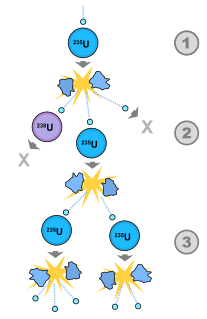
A nuclear chain reaction occurs when one single nuclear reaction causes an average of one or more subsequent nuclear reactions, thus leading to the possibility of a self-propagating series of these reactions. The specific nuclear reaction may be the fission of heavy isotopes. The nuclear chain reaction releases several million times more energy per reaction than any chemical reaction.

Nuclear weapon designs are physical, chemical, and engineering arrangements that cause the physics package of a nuclear weapon to detonate. There are three existing basic design types:
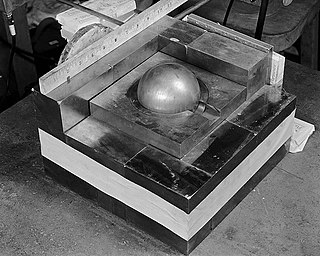
In nuclear engineering, a critical mass is the smallest amount of fissile material needed for a sustained nuclear chain reaction. The critical mass of a fissionable material depends upon its nuclear properties, density, shape, enrichment, purity, temperature, and surroundings. The concept is important in nuclear weapon design.

A breeder reactor is a nuclear reactor that generates more fissile material than it consumes. Breeder reactors achieve this because their neutron economy is high enough to create more fissile fuel than they use, by irradiation of a fertile material, such as uranium-238 or thorium-232, that is loaded into the reactor along with fissile fuel. Breeders were at first found attractive because they made more complete use of uranium fuel than light water reactors, but interest declined after the 1960s as more uranium reserves were found, and new methods of uranium enrichment reduced fuel costs.
A neutron reflector is any material that reflects neutrons. This refers to elastic scattering rather than to a specular reflection. The material may be graphite, beryllium, steel, tungsten carbide, gold, or other materials. A neutron reflector can make an otherwise subcritical mass of fissile material critical, or increase the amount of nuclear fission that a critical or supercritical mass will undergo. Such an effect was exhibited twice in accidents involving the Demon Core, a subcritical plutonium pit that went critical in two separate fatal incidents when the pit's surface was momentarily surrounded by too much neutron reflective material.
A criticality accident is an uncontrolled nuclear fission chain reaction. It is sometimes referred to as a critical excursion, critical power excursion, or divergent chain reaction. Any such event involves the unintended accumulation or arrangement of a critical mass of fissile material, for example enriched uranium or plutonium. Criticality accidents can release potentially fatal radiation doses, if they occur in an unprotected environment.

The light-water reactor (LWR) is a type of thermal-neutron reactor that uses normal water, as opposed to heavy water, as both its coolant and neutron moderator – furthermore a solid form of fissile elements is used as fuel. Thermal-neutron reactors are the most common type of nuclear reactor, and light-water reactors are the most common type of thermal-neutron reactor.
In nuclear engineering, prompt criticality describes a nuclear fission event in which criticality is achieved with prompt neutrons alone and does not rely on delayed neutrons. As a result, prompt supercriticality causes a much more rapid growth in the rate of energy release than other forms of criticality. Nuclear weapons are based on prompt criticality, while most nuclear reactors rely on delayed neutrons to achieve criticality.

Aqueous homogeneous reactors (AHR) are a type of nuclear reactor in which soluble nuclear salts are dissolved in water. The fuel is mixed with the coolant and the moderator, thus the name "homogeneous" The water can be either heavy water or ordinary (light) water, both of which need to be very pure.
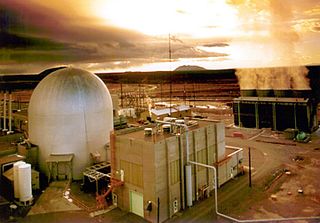
Experimental Breeder Reactor-II (EBR-II) is a sodium-cooled fast reactor designed, built and operated by Argonne National Laboratory at the National Reactor Testing Station in Idaho. It was shut down in 1994. Custody of the reactor was transferred to Idaho National Laboratory after its founding in 2005.
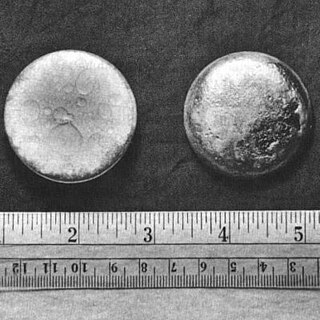
Plutonium is a radioactive chemical element with the symbol Pu and atomic number 94. It is an actinide metal of silvery-gray appearance that tarnishes when exposed to air, and forms a dull coating when oxidized. The element normally exhibits six allotropes and four oxidation states. It reacts with carbon, halogens, nitrogen, silicon, and hydrogen. When exposed to moist air, it forms oxides and hydrides that can expand the sample up to 70% in volume, which in turn flake off as a powder that is pyrophoric. It is radioactive and can accumulate in bones, which makes the handling of plutonium dangerous.

The demon core was a spherical 6.2-kilogram (14 lb) subcritical mass of plutonium 89 millimetres (3.5 in) in diameter, manufactured during World War II by the United States nuclear weapon development effort, the Manhattan Project, as a fissile core for an early atomic bomb. It was involved in two criticality accidents, on August 21, 1945, and May 21, 1946. The core was intended for use in a possible third nuclear weapon to be dropped on Japan, but when Japan's surrender made this unnecessary, it was used for testing. It was designed with a small safety margin to ensure a successful explosion of the bomb. The device briefly went supercritical when it was accidentally placed in supercritical configurations during two separate experiments intended to guarantee the core was close to the critical point. The incidents happened at the Los Alamos Laboratory in 1945 and 1946, resulting in the acute radiation poisoning and subsequent deaths of scientists Harry Daghlian and Louis Slotin, respectively. After these incidents the spherical plutonium core was referred to as the "demon core".
A modulated neutron initiator is a neutron source capable of producing a burst of neutrons on activation. It is a crucial part of some nuclear weapons, as its role is to "kick-start" the chain reaction at the optimal moment when the configuration is prompt critical. It is also known as an internal neutron initiator. The initiator is typically placed in the center of the plutonium pit, and is activated by impact of the converging shock wave.
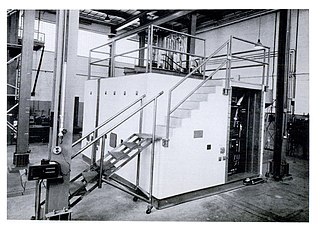
Clementine was the code name for the world's first fast-neutron reactor, also known as the Los Alamos fast plutonium reactor. It was an experimental-scale reactor. The maximum output was 25 kW and was fueled by plutonium and cooled by liquid mercury. Clementine was located at Los Alamos National Laboratory in Los Alamos, New Mexico. Clementine was designed and built in 1945–1946 and first achieved criticality in 1946 and full power in March 1949. The reactor was named after the song "Oh My Darling, Clementine." The similarities to the song were that the reactor was located in a deep canyon and the reactor operators were 49'ers, as 49 was one of the code names for plutonium at the time.

The hydrogen-moderated self-regulating nuclear power module (HPM), also referred to as the compact self-regulating transportable reactor (ComStar), is a type of nuclear power reactor using hydride as a neutron moderator. The design is inherently safe, as the fuel and the neutron moderator is uranium hydride UH3, which is reduced at high temperatures (500–800 °C) to uranium and hydrogen. The gaseous hydrogen exits the core, being absorbed by hydrogen absorbing material such as depleted uranium, thus making it less critical. This means that with rising temperature the neutron moderation drops and the nuclear fission reaction in the core is dampened, leading to a lower core temperature. This means as more energy is taken out of the core the moderation rises and the fission process is stoked to produce more heat.

Raemer Edgar Schreiber was an American physicist from McMinnville, Oregon who served Los Alamos National Laboratory during World War II, participating in the development of the atomic bomb. He saw the first one detonated in the Trinity nuclear test in July 1945, and prepared the Fat Man bomb that was used in the bombing of Nagasaki. After the war, he served at Los Alamos as a group leader, and was involved in the design of the hydrogen bomb. In 1955, he became the head of its Nuclear Rocket Propulsion (N) Division, which developed the first nuclear-powered rockets. He served as deputy director of the laboratory from 1972 until his retirement in 1974.

Kilopower is an experimental project aimed at producing new nuclear reactors for space travel. The project started in October 2015, led by NASA and the DoE’s National Nuclear Security Administration (NNSA). As of 2017, the Kilopower reactors were intended to come in four sizes, able to produce from one to ten kilowatts of electrical power (1-10 kWe) continuously for twelve to fifteen years. The fission reactor uses uranium-235 to generate heat that is carried to the Stirling converters with passive sodium heat pipes. In 2018, positive test results for the Kilopower Reactor Using Stirling Technology (KRUSTY) demonstration reactor were announced.
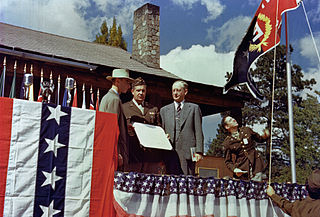
The Los Alamos Laboratory, also known as Project Y, was a secret laboratory established by the Manhattan Project and operated by the University of California during World War II. Its mission was to design and build the first atomic bombs. Robert Oppenheimer was its first director, serving from 1943 to December 1945, when he was succeeded by Norris Bradbury. In order to enable scientists to freely discuss their work while preserving security, the laboratory was located in a remote part of New Mexico. The wartime laboratory occupied buildings that had once been part of the Los Alamos Ranch School.
Dwight Smith Young was an American "carpenter, photographer, archaeologist, cook, meteorologist, poet and self-made physicist" who took part in the Manhattan Project. He was given the nickname "The Hermit of Pajarito Canyon" after making his home in an old log cabin in a remote canyon on the Los Alamos testing site from roughly 1946 to 1952.














